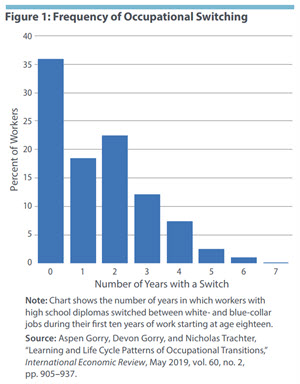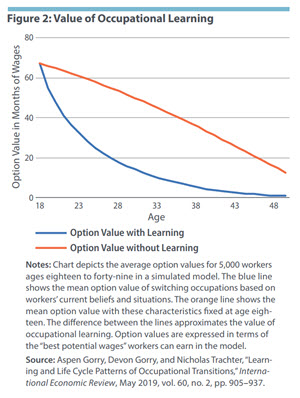Switching Occupational Categories
Worker mobility, across jobs and across state lines, has fallen in recent decades. Changing jobs is one way workers gain new skills and improve their wages. New research also suggests that switching between white-collar and blue-collar occupations enables workers to learn valuable information about their abilities and the types of jobs they are best suited for. Any frictions inhibiting the ability of workers to switch occupations would be costly, particularly for young workers.
Interstate migration has been falling in the United States over the past three to four decades.1 One of the main reasons people move is to change jobs. Indeed, some researchers have blamed the decline in geographic mobility at least in part on the fact that workers in the United States are changing jobs less frequently than they used to.2 According to one study, the rates at which employees quit their jobs and start new ones have fallen by between 10 percent and 38 percent over the past two decades.3
Economists are interested in this decline in labor market "dynamism" because job switching is believed to play a key role in how workers gain new skills and raise their incomes. Many workers change jobs within the same industry or even within the same company to build their skills and climb the job ladder to better-paying positions. But workers also benefit from being able to switch between broad occupational categories — that is, switching from a white-collar job to a blue-collar job. Young workers in particular may switch occupations to experiment and identify the type of work they are best suited for early in their careers to maximize their lifetime earnings.
Calculating the value of the option to switch occupations can shed light on the potential costs of the recent decline in job mobility. Three authors of this Economic Brief (Gorry, Gorry, and Trachter) have created a model of occupational switching to examine which workers change between white- and blue-collar jobs and to quantify the value of having the option to change jobs.
Modeling Occupational Transitions
Roughly one-fifth of high school educated workers from ages eighteen to twenty-eight switch between white- and blue-collar occupations each year. Additionally, nearly half of these workers switch occupations more than once during the first ten years of their careers. (See Figure 1 below.) These findings come from the 1979 National Longitudinal Survey of Youth (NLSY79) conducted by the Bureau of Labor Statistics, which surveyed a sample of more than 12,000 fourteen-year-olds to twenty-two-year-olds in 1979 and tracked them every year until 1994 and every other year thereafter. This dataset allows researchers to follow workers throughout their careers and see when and how often they switch occupations.
Once they switch occupations, workers in the model remain close to the threshold for switching. As a result, a small change in their beliefs in the other direction would induce them to switch occupations again. If they do switch again, the model predicts they would do so faster than the first time. This aspect of the model captures the fact that in the NLSY79 data, a large share of workers who switch occupations do so more than once, and those who do switch multiple times do so faster the second time than the first.
This finding contrasts with previous studies on job switching that suggested individuals change jobs less frequently as they get older. This pattern of less-frequent job switching seems to be true for individuals with strong initial beliefs about the types of jobs they are best suited for. But workers who have beliefs on the margin are more likely to switch occupations many times before finding the occupations they are best suited for. In their paper, Gorry, Gorry, and Trachter observe that this behavior doesn't seem to fit with models of job switching that assume workers change occupations simply to gain skills, since it would imply that they gain skills faster as they age. Instead, workers who switch occupations multiple times are learning about themselves and the type of work they can do most productively. This learning drives occupational switching in the model.
The Value of Learning by Switching
Gorry, Gorry, and Trachter use their model to estimate the value of being able to switch between types of occupations. They compute the value of switching for workers based on their occupations and beliefs across time as they age. For the average eighteen-year-old, being able to switch is worth an estimated sixty-seven months of his or her best potential wage (the maximum wage the worker could earn in the model). That value falls to less than one month of wages by age forty-nine.
Having the option to switch occupations becomes less valuable for workers as they age for two reasons. First, they learn more about themselves and their abilities early in their career, and second, older workers have less time to capitalize on the benefits of learning about their abilities.
These estimates suggest that being able to switch occupations is valuable to workers, particularly those workers who do not have a strong initial sense of what type of job they will be best suited for. Changing occupations allows workers to learn about themselves and their abilities, and finding the right occupation early can pay dividends throughout their careers. It follows that external factors that make it harder for workers to switch occupations are costly frictions.
Aspen Gorry and Devon Gorry are assistant professors in the John E. Walker Department of Economics at Clemson University. Tim Sablik is an economics writer and Nicholas Trachter is a senior economist in the Research Department at the Federal Reserve Bank of Richmond.
Greg Kaplan and Sam Schulhofer-Wohl, "Understanding the Long-Run Decline in Interstate Migration," International Economic Review, February 2017, vol. 58, no. 1, pp. 57–94.
Raven Molloy, Christopher L. Smith, and Abigail Wozniak, "Declining Migration within the U.S.: The Role of the Labor Market," National Bureau of Economic Research Working Paper No. 20065, April 2014.
Henry R. Hyatt and James R. Spletzer, "The Recent Decline in Employment Dynamics," IZA Journal of Labor Economics, 2013, vol. 2, no. 5, pp. 1–21.
Aspen Gorry, Devon Gorry, and Nicholas Trachter, "Learning and Life Cycle Patterns of Occupational Transitions," International Economic Review, May 2019, vol. 60, no. 2, pp. 905–937.
Gorry, Gorry, and Trachter focus on high school graduates, but their findings are similar for college graduates as well.
This article may be photocopied or reprinted in its entirety. Please credit the authors, source, and the Federal Reserve Bank of Richmond and include the italicized statement below.
Views expressed in this article are those of the authors and not necessarily those of the Federal Reserve Bank of Richmond or the Federal Reserve System.
Receive a notification when Economic Brief is posted online.



